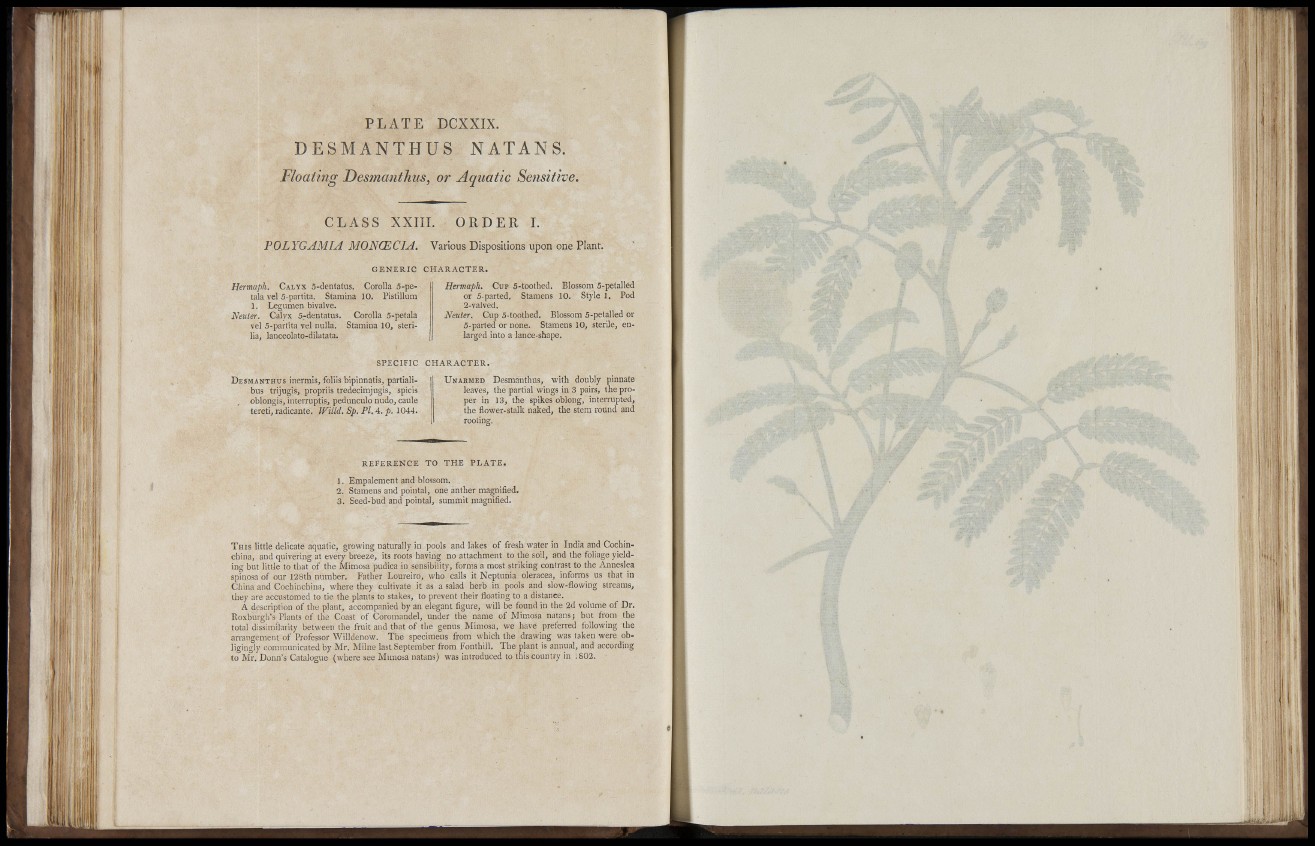
Il'
^fi
PLATE DCXXIX.
D E S M A N T H U S NATAN S.
Floaiing Desmanthus, or Aquatic Sensitive.
CLASS XXIIL ORDER I.
POLYGAMIA MONCECIA. Various Dispositions upon one Plant.
G E N E R I C CHARACTER.
Hermaph. CAL-ÌX 5-dentatus. Corolla 5-petala
vel 5-partita. Stamina 10, Pistillum
1. Legumen bivalve. Neuter. Calyx 5-dentatus. Corolla 5-petaIa
vel 5-partita vel nulla. Stamina 10^ sterilia,
lanceolato-dilatata.
Hermaph. CnF 5-toothed. Blossom 5-petalled
or 5-parted. Stamens 10. Style 1. Pod
2-valved, Neuter. Cup 5-toothed. Blossom 5-petalled ov
5-parted or none. Stamens 10, sterile, enlarged
into a lance-shape.
I f
9
SPECIFIC CHARACTER.
DESMANTHUS inermis, foliis bipinnatis, partialibus
trijugis, propriis tredecimjugis, spicis
UNAHMED Desmanthus, with doubly pinnate
leaves, the partial wings in 3 pairs, the proper
oblongis, interruptis, pedúnculo nudo, caule
tereti, radicante. IVilld. Sp. Pl.i. p. lOiA.
in 13, the spikes oblong, interrapted,
the flower-stalk naked, the stem round and
rooting.
Siili:;
REFERENCE TO THE PLATE.
] . Empalement and blossom.
2. Stamens and pointai, one anther magnified.
3 . Seed-bud and pointai, summit magniiied.
T f l t s little delicate aquatic, growing naturally in pools and lakes of fresh water in India and Cochinchina,
and quivering at every breeze, its roots having no attachment to the soil, and the foliage yielding
but little to that of the JVIimosa pudica in sensibility, forms a most striking contrast to the Anueslea
spinosa of our 128th number. Father Loureiro, who calls it Neptunia oleracea, informs us that in
Ciiina and Cochinchina, where they cultivate it as a salad herb in pools and slow-flowing streams,
ihey are accustomed to tie the plants to stakes, to prevent their floating to a distance.
A description of the plant, accompanied by an elegant figure, will be found in the 2d volume of Dr.
Roxburgh's Plants of the Coast of Cororaandel, under the name of Mimosa natans; but from the
total dissimi'latity between the fruit and that of the genus Mimosa, we have preferred following the
arratigement of Professor Willdenow. The specimens from which the drawing was taken were obligingly
communicated by Mr . Milne last September from Fonthill. The plant is annual, and according
to Mr. Donn' s Catalogue (where see Mimosa natans) v^'as introduced to this country in .802.
l i
.1 I
'I
P '
- 'Î
yiil^
ll
OJi